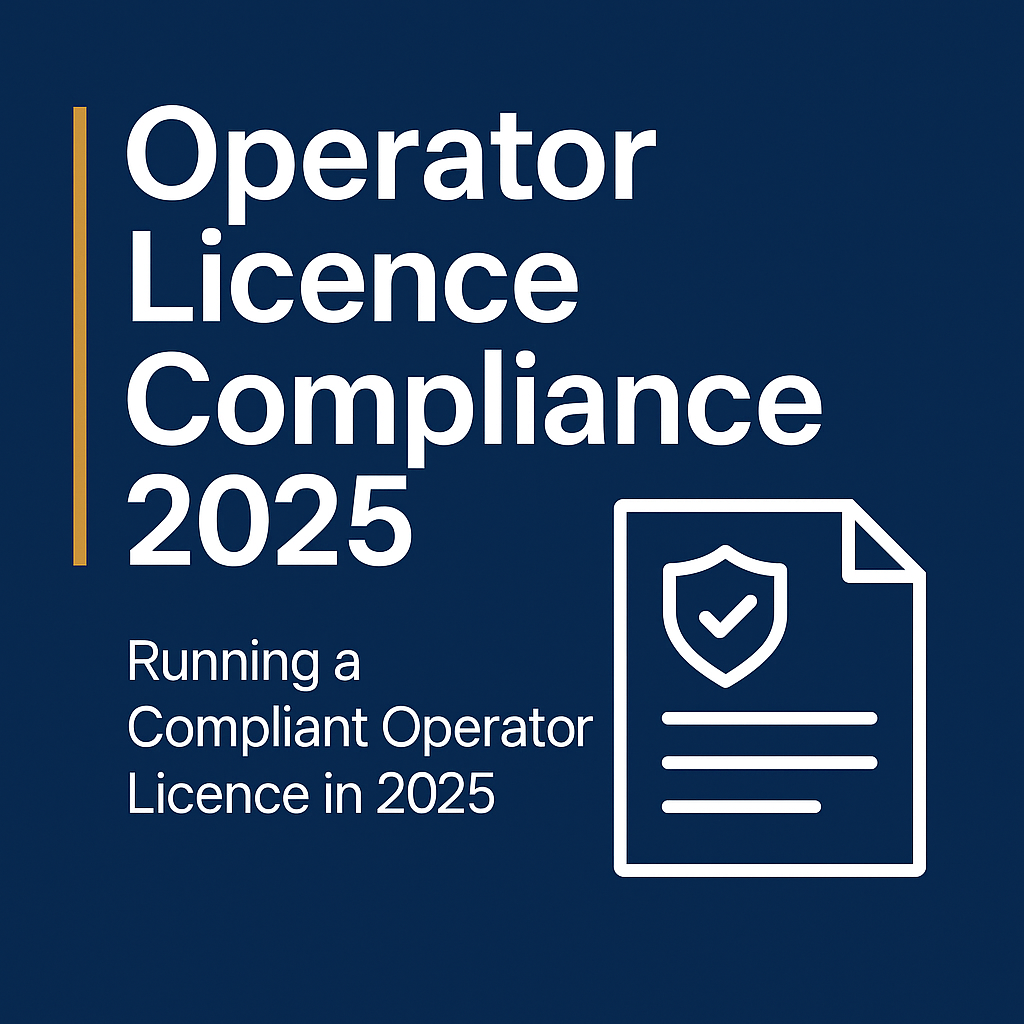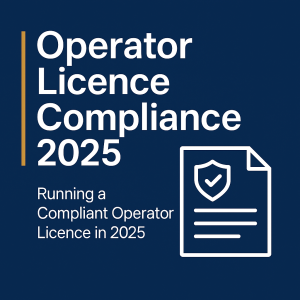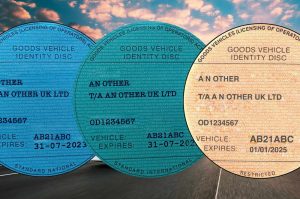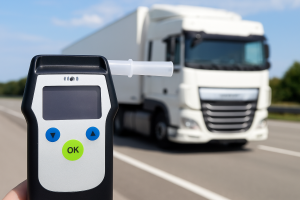Practical, up-to-date steps to keep your O-licence compliant: maintenance & brake testing at every PMI, drivers’ hours/tachographs,
quarterly licence checks, route planning, load security (100/50/50), OCRS and documentation.
Gareth Wildman — Director & Lead Transport Compliance Trainer,
Transcom National Training
•
•
To run a compliant transport operation in 2025, you must maintain full control over vehicle maintenance, driver management, route planning, load security, and documentation. The Senior Traffic Commissioner expects effective and continuous management with evidence that your systems work in practice — not just on paper.
1) Vehicle Maintenance & Roadworthiness
Pre-planned maintenance: Use a forward maintenance planner (at least six months ahead) showing MOTs, safety inspections (PMIs) and brake performance assessments. Set inspection frequency based on mileage, operating environment and manufacturer guidance; six weeks remains a common HGV benchmark where justified.
Daily walkaround checks: A meaningful pre-use inspection must be completed each day the vehicle is operated. Safety-critical defects must be reported immediately and rectified before use. Nil-defect reporting and random audits are strongly advised.
Defect rectification & record retention: Keep evidence that defects were repaired before the vehicle re-entered service. Retain inspection sheets, brake evidence and defect records for at least 15 months. Digital records are acceptable if secure, traceable and printable on request.
Brake performance (April 2025 DVSA GTMR):
- Every PMI must include a brake performance assessment.
- Preferred method: laden roller brake test (RBT). You may do this up to 14 days before the PMI; attach the printout to the inspection sheet.
- For trailers, an EBPMS report may be used if competently reviewed and signed at each PMI.
- If you do not use EBPMS, plan for at least four laden RBTs per year, evenly spaced (the annual test can count).
- If a laden RBT hasn’t been done within 14 days of the PMI, complete a competent risk assessment and evidence performance at that PMI (e.g., unladen RBT with justification).
2) Driver Management & Drivers’ Hours
Monitoring driver hours: Download and analyse tachograph data on time: driver cards every 28 days (max) and vehicle units every 90 days (max). Investigate infringements and record corrective actions.
Driver licensing: Ensure drivers hold the correct and valid entitlement for the vehicle class. Operate a documented, risk-based licence-checking policy with a baseline of every 3 months (monthly for high-risk drivers). Keep auditable evidence of each check.
Discipline & fairness: Enforce clear, proportionate policies for infringements, poor driving or non-compliance. Apply consistently and record outcomes — this demonstrates “effective and continuous control”.
Further reading: Senior Traffic Commissioner: Statutory Document No. 3 (2025)
3) Operational Planning & Route Management
Route restrictions: Plan routes to avoid bridge weight limits, width/height restrictions, Clean Air/LEZ/CAZ zones and local authority bans. Use HGV-compliant navigation; brief drivers and monitor repeat issues.
Speed limits: Enforce legal limits for the vehicle class and road type. Monitor via tachograph or telematics; take corrective action on trends.
Load & weight limits: Keep all loads within gross and axle weight limits; weigh where needed and train drivers on consequences of overloads.
Load security – percentage rule: Secure loads to withstand 100% of the load’s weight forward, 50% sideways, and 50% rearward. Select restraints with adequate lashing capacity (LC), protect webbing from sharp edges, use suitable anchor points, and re-tension after the first few miles. Document your method for unusual loads and keep evidence (photos/notes) with the job file.
Reference: DVSA: Load Securing – Vehicle Operator Guidance (2023, current)
ADR (dangerous goods): Where applicable, comply with ADR/CDG requirements (driver training, equipment, documentation, approvals) and keep records up to date.
4) Documentation & Evidence
Maintain accurate, accessible records for: safety inspections, brake evidence, defect rectification, tachograph downloads/analysis and corrective actions, driver licence checks and CPC records, MOTs, accidents/incidents, and your written procedures (maintenance, hours, load security, disciplinary).
Digital or paper is fine — the crucial test is security, auditability and retrieval speed during DVSA/TC inspection.
5) Continuous Improvement, Auditing & OCRS
Internal audits: Audit maintenance, drivers’ hours and record-keeping systems at least annually (more often for multi-site or higher-risk operations). Record findings, root causes and completion dates for corrective actions.
OCRS: Register for DVSA’s Operator Compliance Risk Score service and review trends. If your score worsens, investigate immediately (brakes, paperwork, defects) and apply corrective action. See: Maintain your vehicles’ OCRS
CPD: Evidence ongoing knowledge. A 2-Day Transport Manager Refresher or OLAT every five years (or sooner if issues arise) is the expected benchmark.
6) Summary – Compliance Every Day
- Pre-planned maintenance with brake performance at every PMI. (DVSA GTMR)
- Daily walkaround checks and defect-to-rectification evidence.
- Drivers’ hours monitored; downloads on time; infringements managed.
- Licence checks every 3 months (monthly if high-risk).
- Route planning that avoids restrictions; load security 100/50/50.
- Records that are complete, secure and quickly retrievable.
- Regular audits, OCRS monitoring and documented CPD — see:
2-Day TM Refresher,
OLAT,
Driver CPC courses,
compliance resources & downloads.
FAQ – Running a Compliant Operation (2025)
1) How often should vehicles be safety inspected?
Intervals depend on mileage, vehicle type and operating conditions. For most HGV fleets, 6 weeks is a common benchmark where justified by risk assessment. Vehicles must be fit and serviceable at all times.
2) Is a brake test required at every PMI?
Yes. According to the DVSA Guide to Maintaining Roadworthiness (April 2025), every PMI requires a brake performance assessment. Prefer a laden RBT (allowed up to 14 days before the PMI with the printout attached). For trailers, EBPMS can be used if reviewed and signed at each PMI. If you don’t use EBPMS, plan for at least four laden RBTs per year, evenly spaced (the annual test can count). If no suitable laden RBT exists within 14 days of the PMI, complete a competent risk assessment and evidence braking performance at that inspection.
3) How long must maintenance and defect records be kept?
Keep safety-inspection sheets, brake reports and defect/rectification records for at least 15 months. Nil-defect reports are typically retained for at least 3 months. Digital records are acceptable if secure, tamper-evident and printable.
4) What’s the correct process for driver walkaround checks?
Drivers must complete a meaningful pre-use check every day. Inspect brakes, tyres, lights, mirrors, load security and warning systems. Safety-critical defects must be reported immediately and rectified before use. Audit your defect system and retain signed reports.
5) How often should tachograph data be downloaded?
Driver cards: every 28 days (max). Vehicle units: every 90 days (max). Investigate infringements promptly and record corrective actions.
6) How often should driver licences be checked?
Baseline: every 3 months for all drivers, with monthly checks for high-risk drivers. Maintain a written risk-based policy and keep auditable evidence of each check.
7) What is the Operator Compliance Risk Score (OCRS)?
OCRS tracks an operator’s roadside/test performance. Scores are colour-coded (Green/Amber/Red). Register on GOV.UK, monitor trends and correct issues early.
8) What training should Transport Managers and Operators complete?
Ongoing CPD is expected. A 2-Day Transport Manager Refresher or OLAT every five years, or sooner after compliance issues or before/after a Public Inquiry.
9) What are common causes of Public Inquiry?
Incomplete maintenance files; no brake evidence at PMIs; weak defect reporting; unmanaged tachograph infringements; no licence-checking system; Transport Manager not exercising effective control.
10) How must loads be secured under DVSA rules?
Use the percentage rule: your securing system must withstand 100% of the load’s weight forward, 50% sideways and 50% rearward. Choose restraints with adequate LC, protect webbing from sharp edges, use suitable anchor points and re-tension after the first few miles. Document methods for unusual loads and keep evidence.
11) Are digital maintenance systems acceptable to DVSA?
Yes — provided they are secure, auditable, produce printable reports/signatures and allow rapid retrieval during inspection. (Examples include platforms like Fleet Fixation.)
12) What happens if I breach my Operator Licence undertakings?
Possible outcomes: DVSA visits, warnings, vehicle curtailment, suspension or revocation, and Public Inquiry. Serious or repeated failures risk loss of repute for the Transport Manager.
13) How do I prove continuous and effective control?
Keep evidence that the Transport Manager is actively involved: reviews maintenance/brake reports; signs off tachograph analyses and infringement actions; checks licences and training records; oversees audits and corrective actions; signs procedures and updates.
14) Where can I access the latest official guidance?
Use GOV.UK for the latest editions of the Guide to Maintaining Roadworthiness (April 2025), Statutory Document No. 3 (2025), DVSA OCRS guidance (2024) and the DVSA Load Security Code of Practice (2023 – current).
Official Sources & Further Reading
- DVSA – Guide to Maintaining Roadworthiness (April 2025)
- Senior Traffic Commissioner – Statutory Document No. 3 (2025)
- DVSA – Operator Compliance Risk Score (OCRS) Guidance (2024)
- DVSA – Load Security Code of Practice (2023, current 2025)








